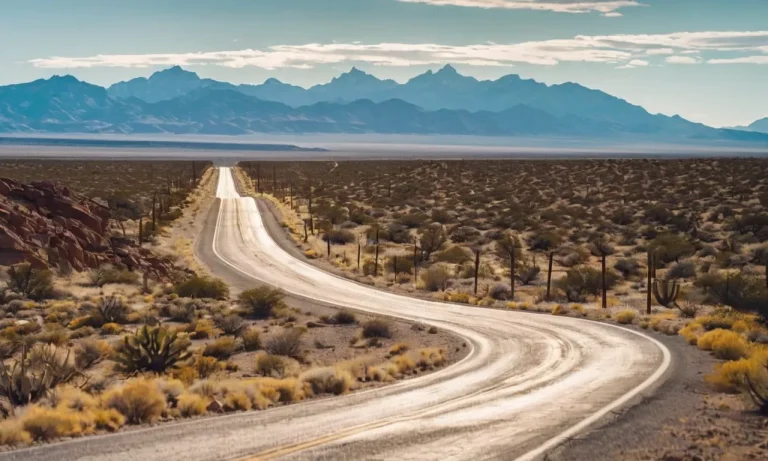What Is The Flattest Country In Europe?
Europe is known for its diverse landscapes, from the soaring Alps to lush green valleys. But which European country has the flattest terrain? If you’re pressed for time, the answer is the Netherlands, where over 50% of the land is less than 1 meter above sea level.
In this comprehensive guide, we will explore why the Netherlands earned the title of the flattest country in Europe. We’ll look at key facts and figures about the geography and topography of the Netherlands and how it compares to its European neighbors.
We’ll also learn about some of the implications of having such a low-lying landscape.
Defining ‘Flat’ Geography
When it comes to defining what makes a landscape “flat,” there are several key factors to consider, including elevation, relief, and slope. Elevation refers to the height of a landform above sea level, while relief describes the difference in elevation between the highest and lowest points of an area.
Slope, on the other hand, measures the steepness or incline of the land’s surface.
In order for a country to be considered flat, it typically needs to have a low relief and minimal variations in elevation. This means that there are no significant mountains, hills, or valleys that disrupt the overall flatness of the terrain.
Instead, the land is characterized by vast expanses of level ground, often extending for miles.
Standards for calculating flatness and average elevations
When it comes to calculating the flatness of a country, there are different standards that can be used. One commonly used method is to measure the average elevation of the land. By taking the sum of all elevation measurements and dividing it by the total number of measurements, an average elevation can be determined.
For example, in the case of the Netherlands, which is often considered the flattest country in Europe, the average elevation is relatively low. The country’s highest point, Vaalserberg, stands at just 322.7 meters above sea level.
In contrast, the lowest point, Zuidplaspolder, is approximately 6.76 meters below sea level. This combination of low average elevation and below-sea-level areas contributes to the country’s overall flatness.
It’s worth noting that there are other countries in Europe that also boast relatively flat landscapes. Countries like Denmark, Belarus, and Ukraine have large areas of low-lying land that contribute to their flatness.
However, when considering factors such as relief and slope, the Netherlands often takes the title of the flattest country in Europe.
For more information on the flatness of European countries, you can visit www.worldatlas.com.
The Extreme Flatness of the Netherlands
The Netherlands is renowned for its remarkably flat landscape, making it the flattest country in Europe. With a significant portion of its land lying below sea level, the country’s flatness is truly extraordinary. Let’s explore some fascinating facts about the extreme flatness of the Netherlands.
– Over 50% of land below 1 meter above sea level
One of the most remarkable aspects of the Netherlands’ flatness is the fact that over 50% of its land is situated below just one meter above sea level. This unique geographical feature is a result of centuries of land reclamation and water management efforts.
The Dutch have ingeniously constructed an elaborate system of dikes, canals, and pumps to control water levels and prevent flooding. The iconic windmills that dot the landscape are an integral part of this system, helping to drain excess water from the low-lying areas.
– One of the lowest average elevations in Europe
The Netherlands boasts one of the lowest average elevations in Europe, with its highest point, the Vaalserberg, reaching just 322.7 meters above sea level. This relatively low elevation contributes to the country’s flatness, as there are no significant mountain ranges or hills to disrupt the predominantly flat terrain.
The absence of steep inclines makes the Netherlands an ideal destination for cycling enthusiasts who can enjoy long and leisurely rides through the picturesque countryside.
– Limited elevation changes and very gradual slopes
The flatness of the Netherlands is further emphasized by the limited elevation changes and very gradual slopes found throughout the country. Unlike other European countries with diverse topography, such as Switzerland or Norway, the Netherlands offers a landscape that is consistently level.
This characteristic is especially evident in the vast polder areas, which are areas of land that have been reclaimed from the sea. The polders are typically characterized by their uniformity and lack of significant changes in elevation.
The extreme flatness of the Netherlands not only defines its physical geography but also influences various aspects of life in the country. It has shaped the Dutch culture, economy, and even transportation infrastructure.
The Netherlands’ expertise in water management and land reclamation has made it a global leader in these fields, with its innovative solutions being sought after by countries facing similar challenges.
To learn more about the Netherlands’ unique flatness and its impact on the country, you can visit www.holland.com, the official website of the Netherlands Board of Tourism and Conventions.
Comparing the Netherlands to Other European Countries
Contrasting with mountainous areas like Switzerland and Austria
When it comes to flatness, the Netherlands stands out in Europe. Contrasting with countries like Switzerland and Austria, which are known for their majestic mountains and breathtaking landscapes, the Netherlands takes a completely different approach.
With an average elevation of just 30 meters above sea level, it is safe to say that the Dutch landscape is predominantly flat. While the mountains of Switzerland and Austria offer thrilling skiing adventures and stunning alpine vistas, the Netherlands offers a unique charm with its expansive plains and picturesque windmills.
The Netherlands’ flatness has been a defining characteristic of the country for centuries. It has shaped the Dutch culture and influenced various aspects of life, including transportation, agriculture, and even architecture.
The absence of rugged terrain has made it easier for the Dutch to build an extensive network of canals and dikes, which are essential for managing water levels and preventing flooding.
More extreme flatness than Nordic countries
While the Nordic countries, such as Sweden, Norway, and Finland, are often associated with vast landscapes and untouched wilderness, they cannot compete with the extreme flatness of the Netherlands. The Nordic countries do have their fair share of flat areas, especially in the coastal regions, but they also boast majestic mountain ranges and vast forests.
In contrast, the Netherlands is known for its pancake-like geography. The majority of the country is characterized by low-lying polders, reclaimed land, and reclaimed lakes. The absence of significant elevation changes makes it an ideal place for cycling enthusiasts who can enjoy long, leisurely rides through the countryside without having to worry about steep hills.
Similar in parts to Belgium and Denmark but still flatter on average
When comparing the Netherlands to neighboring countries like Belgium and Denmark, similarities can be found. All three countries share a relatively flat landscape, making them ideal for agricultural activities. However, the Netherlands still stands out as the flattest among them.
In Belgium, the Ardennes region offers a hilly and forested terrain, providing a stark contrast to the flat plains found in the northern part of the country. Similarly, Denmark has rolling hills and coastal cliffs that add variety to its landscape.
Even though the Netherlands shares some similarities with these countries, it maintains its reputation as the flattest country in Europe.
It’s worth noting that the flatness of the Netherlands is not uniform throughout the entire country. Certain regions, such as the province of Flevoland, are exceptionally flat, while others may have slightly more undulating landscapes.
Nevertheless, when considering the average topography, the Netherlands remains unparalleled in its flatness.
Impacts and Implications of Having Such Flat Land
– Increased flood risks from rivers and sea
One of the significant impacts of living in the flattest country in Europe is the increased risk of flooding from rivers and the sea. With little natural elevation to slow down or divert the flow of water, flat landscapes are more susceptible to flooding during heavy rainfall or storm surges.
The Netherlands, known for its flat terrain, faces this challenge regularly. In fact, nearly a third of the country would be underwater if not for their extensive system of dikes, dams, and flood protection infrastructure.
The potential consequences of flooding are severe, impacting not only human settlements but also the environment, infrastructure, and economy. It can lead to property damage, displacement of residents, loss of crops, and disruption of transportation networks.
Efforts to mitigate these risks include constant monitoring of water levels, maintaining and improving flood defenses, and implementing innovative water management strategies.
– Reliance on dykes and water infrastructure for protection
The flatness of the land in Europe’s flattest country necessitates heavy reliance on dykes and water infrastructure for protection against floods. The Dutch have been experts in this regard, with a long history of building and maintaining dykes to manage water levels and prevent inundation of low-lying areas.
The extensive network of dykes and water infrastructure plays a crucial role in safeguarding the country’s population, infrastructure, and agricultural lands. Regular inspections, maintenance, and reinforcement of these structures are essential to ensure their effectiveness in the face of changing climate patterns and increasing sea levels.
It is worth noting that the Dutch approach to water management has gained international recognition and has been studied and emulated in other countries facing similar challenges.
– Agricultural benefits for crops in flat fields
While the flatness of the land brings challenges, it also offers significant agricultural benefits. Flat fields provide an ideal environment for large-scale farming and mechanized agriculture. The absence of steep slopes allows for efficient use of machinery, making it easier to plant, cultivate, and harvest crops.
The Netherlands, being a prime example of a flat country, has capitalized on this advantage and has become a major player in the global agricultural industry. The fertile soil, combined with advanced agricultural techniques, has made it possible to achieve high yields of crops such as potatoes, vegetables, and flowers.
Moreover, the flatness of the land allows for efficient irrigation and drainage systems, ensuring optimal water management for agricultural activities. This contributes to the country’s food security and economic prosperity.
Efforts to Preserve and Reclaim Land
Throughout history, countries around the world have engaged in various efforts to preserve and reclaim land for different purposes. Europe, being home to diverse landscapes and terrains, has had its fair share of such endeavors.
One notable aspect is the history of drainage projects to claim land from wetlands, which has been a common practice in many European countries.
History of drainage projects to claim land from wetlands
For centuries, European countries have been reclaiming land from wetlands through drainage projects. These projects involve the construction of intricate systems of canals, dikes, and pumps to drain excess water and create new land for agriculture, urban development, and other purposes.
The Netherlands, for example, is renowned for its extensive system of polders, which are areas of land reclaimed from the sea or lakes.
These drainage projects have not only expanded the available land for human use but have also played a crucial role in flood prevention. By regulating water levels and managing drainage, these countries have been able to mitigate the risk of catastrophic floods and protect their population from natural disasters.
Ongoing sand replenishment to combat beach erosion
In addition to land reclamation from wetlands, many European coastal countries have also been actively involved in efforts to combat beach erosion. Beaches are important natural assets and attract millions of tourists each year.
However, the constant action of waves and tides can erode the shoreline, threatening the viability of these beaches and impacting the local economy.
To counter this, countries like the Netherlands, Germany, and Denmark have implemented ongoing sand replenishment projects. These projects involve the importation of sand to restore eroded beaches and maintain their natural beauty.
By replenishing the sand regularly, these countries ensure the stability and attractiveness of their coastal areas, supporting tourism and protecting the environment.
Debate around impacts of climate change
While efforts to preserve and reclaim land have been successful in many cases, the ongoing debate around the impacts of climate change raises concerns about the long-term viability of these projects. Rising sea levels, increased storm intensity, and other climate-related factors pose significant challenges to land reclamation and beach erosion prevention.
Scientists and environmentalists argue that these efforts may not be sustainable in the face of climate change. They emphasize the need for adaptive strategies that consider the evolving nature of coastal environments and prioritize natural solutions such as coastal wetland conservation and the creation of artificial reefs.
It is important for policymakers and stakeholders to balance the economic benefits of land reclamation and beach preservation with the potential environmental consequences. By incorporating climate change considerations into their plans and adopting sustainable practices, European countries can continue to protect and utilize their land and coastlines for generations to come.
Conclusion
With over half its land below sea level, the Netherlands stands out as extraordinarily flat, especially compared to other European countries. This extreme flatness has presented both benefits, like fertile land for agriculture, and challenges like increased flooding.
Massive engineering efforts continue today to protect the Netherlands from rising seas and preserve its vast flat lands into the future.








